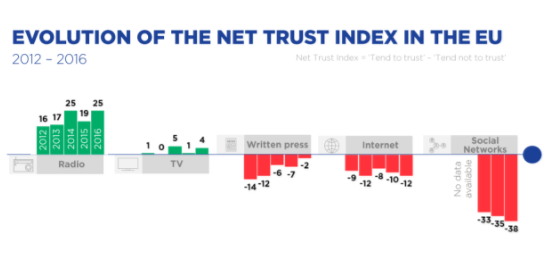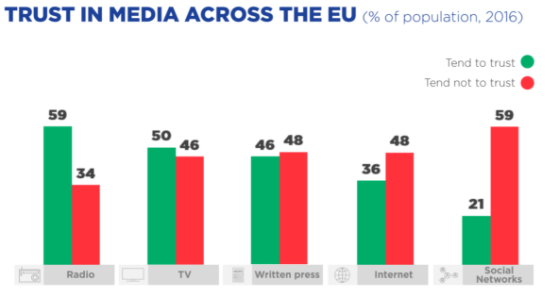 English available languages
English available languages
What do stories about Hilary Clinton selling weapons to ISIS, Donald Trump being endorsed by the Pope and the EU costing the UK £350 million every week have in common? They are all examples of fake news, a term that became commonplace following the 2016 US presidential election and the UK’s referendum on membership of the EU. Both political campaigns were affected by untrue stories going viral on social media.
The problem was large enough for Facebook to announce a raft of measures to help combat the spread of fake news. These included publishing tips on how to spot fake news, creating a tool to flag up suspicious stories and employing fact-checking agencies to stop untrue stories before they go viral.
However, it looks as though the damage may already be done, at least as far as Europe is concerned. Social media is by far the least trusted form of media across the continent, according to data gathered by the European Commission. Only 36% of EU citizens tend to trust the internet, and just 21% of EU citizens say they trust social networks. In every single one of the 33 European countries surveyed by the Commission, those who did not trust social media outnumbered those who did trust it.
Which European country has the most trusted media? https://t.co/hlvjqjElqs pic.twitter.com/zvY51tM3DU
— World Economic Forum (@wef) 24. lipnja 2017.
The countries least trusting of social media were France and Sweden, according to analysis of the data by the European Broadcasting Union (EBU) in its Trust in Media 2017 report. EBU’s analysis also showed weakening trust of the internet in general, with 24 out of 32 European countries recording a decline in trust of the internet over the five years from 2012 to 2016.
Traditional boost
Perhaps most surprising was the fact that the decline in trust of social media and the internet was not mirrored by a decline in trust of other parts of the media. Traditional media – radio, TV, and the written press – were all trusted more by European citizens than they were a year previously. EBU’s Net Trust Index, which calculates the difference between the percentage of survey respondents who do and do not trust different forms of media, found that Radio increased from a net trust score of 19 in 2015 to 25 in 2016.
 TV similarly received a boost, jumping from a net trust score of 1 to 4, while the level of negative feelings towards Europe’s written press weakened from -7 in to 2015 to -2 last year.
TV similarly received a boost, jumping from a net trust score of 1 to 4, while the level of negative feelings towards Europe’s written press weakened from -7 in to 2015 to -2 last year.
Radio is by far the most trusted form of media in Europe, with 59% of people across the continent trusting it in 2016. TV was the only other form of media to be viewed as more trustworthy (50%) than untrustworthy (48%) across the continent as a whole.
Regional variations
While radio was the most trusted form of media in Europe in 2016, there were huge variations in where people liked to get their news from, depending on where in the continent they live. It is mainly south-eastern European citizens, together with those in the UK, that show the least trust in the written press, while western European citizens show the least trust in social networks.
Trust in radio and TV is highest in the Nordic regions. In Finland, for example, 82% of people tend to trust radio and 78% trust TV. Similarly, Sweden – second only to France in the level of distrust shown to social media – was second only to Finland in the level of trust it showed to radio (82%) and TV (72%).

As the most of of South-Eastern Europe (as well as Eastern Europe), Montenegrins trust TV the most. To note that in Greece (and partially in Serbia), people mostly trust the Internet media.
The head of the EBU’s Media Intelligence Service, Roberto Suarez, said the huge variations and general decline in trust in social media were signs that Europeans were responding to fake news and learning to navigate the “post-truth” media landscape. He said:
“In this post-truth world, it is encouraging to see the public can differentiate between competing sources of news and have chosen to put their trust in more traditional media. As public service broadcasters, it is the job of our members to cherish and maintain that level of trust and continue to provide impartial, independent reporting to counter the spread of fake news and the limitation of filter bubbles on social media.”
Source: WEF
 English available languages
English available languages
